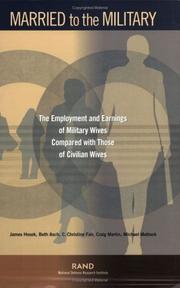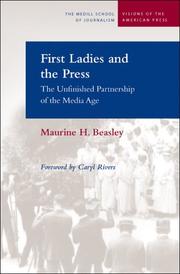| Listing 1 - 10 of 11 | << page >> |
Sort by
|
Book
ISBN: 0833093959 9780833093950 Year: 2015 Publisher: RAND Corporation
Abstract | Keywords | Export | Availability | Bookmark
 Loading...
Loading...Choose an application
- Reference Manager
- EndNote
- RefWorks (Direct export to RefWorks)
"The frequent relocations associated with military service place distinct demands on service members and their families and can complicate military spouses' career trajectories. Recognizing this challenge, the White House published a directive in 2011 ordering the Department of Defense to expand the Army Spouse Employment Partnership, which had recruited 52 employer partners since its inception in 2003 to assist military spouses seeking employment, to serve Navy, Marine Corps, and Air Force spouses. The resulting Military Spouse Employment Partnership, launched on June 29, 2011, is one of four initiatives under the Department of Defense's Spouse Education and Career Opportunities program. In December 2014, the U.S. Congress mandated an evaluation of the Partnership and the Office of the Deputy Assistant Secretary of Defense for Military Community and Family Policy sponsored RAND to assess the extent to which the Partnership addresses its objectives. This report documents the first phase of research to help meet the congressional requirement for a 'report evaluating the progress of military spouse employment programs.' This research should be of interest to policymakers responsible for programs or oversight of programs supporting military spouse quality of life, as well as scholars who study military spouse issues and program evaluation"--Publisher's web site
Military spouses --- Employment --- Military wives --- Spouses
Book
ISBN: 0833093304 9780833093301 Year: 2015 Publisher: RAND Corporation
Abstract | Keywords | Export | Availability | Bookmark
 Loading...
Loading...Choose an application
- Reference Manager
- EndNote
- RefWorks (Direct export to RefWorks)
Military spouses --- Mental health services --- Services for --- Military wives --- Spouses

ISBN: 1282283006 9786612283000 0833034006 0833031805 9780833034007 9781282283008 9780833031808 Year: 2002 Publisher: RAND Corporation
Abstract | Keywords | Export | Availability | Bookmark
 Loading...
Loading...Choose an application
- Reference Manager
- EndNote
- RefWorks (Direct export to RefWorks)
Today's military is a military of families; many service members are married, and many of their spouses work and contribute to family income. But military wives earn less than civilian wives, and this study seeks to understand why. The authors find that military wives, knowing they are likely to move frequently, are willing to accept jobs that offer a lower wage rather than to use more of their remaining time at a location to find a higher-wage job. Compared with civilian wives, military wives tend to work somewhat less if they have young children but somewhat more if their children are older.
Military spouses. --- Wives. --- Military spouses --- Married women --- Wages --- Military & Naval Science --- Law, Politics & Government --- Military Administration --- Employment --- Women --- Wives --- Salaries, etc --- United States --- Armed Forces --- Recruiting, enlistment, etc. --- Military wives --- Spouses --- Housewives

ISBN: 0810162342 0810123126 Year: 2005 Publisher: Evanston, Ill. : Northwestern University Press,
Abstract | Keywords | Export | Availability | Bookmark
 Loading...
Loading...Choose an application
- Reference Manager
- EndNote
- RefWorks (Direct export to RefWorks)
Presidents' spouses --- Mass media --- Press and politics --- Press coverage --- Political aspects --- United States --- Politics and government --- Presidents --- Presidents' wives --- Spouses --- Wives
Book
ISBN: 1000692922 0429345232 9780429345234 9781000692921 9781000693102 1000693104 9780367363130 9781000693287 1000693287 9780367363123 0367363135 0367363127 Year: 2019 Publisher: New York ; London : Routledge,
Abstract | Keywords | Export | Availability | Bookmark
 Loading...
Loading...Choose an application
- Reference Manager
- EndNote
- RefWorks (Direct export to RefWorks)
This book describes the ways in which married women appeared in legal practice in the medieval Swedish realm 1350-1450, through both the agency of women, and through the norms that surrounded their actions. Since there were no court protocols kept, legal practice must be studied through other sources. For this book, more than 6,000 original charters have been researched, and a database of all the charters pertaining to women created. This enables new findings from an area that has previously not been studied on a larger scale, and reveals trends and tendencies regarding aspects considered central to married women's agency, such as networks, criminal liability, and procedural capacity.
Married women --- Legal status, laws, etc. --- History --- Married people --- Women --- Wives
Multi
ISBN: 9780816539246 0816539243 9780816501984 081650198X 9780816531455 Year: 2015 Publisher: University of Arizona Press
Abstract | Keywords | Export | Availability | Bookmark
 Loading...
Loading...Choose an application
- Reference Manager
- EndNote
- RefWorks (Direct export to RefWorks)
"The book uncovers the social, educational, and cultural tools rural Mexican women employ to creatively survive the conditions created by migration. It addresses the material conditions that lead to the migration of adults from the area, but at the core are the educational and personal endeavors of women to get ahead without the men in their families"--Provided by publisher.
Mexicans --- Immigrants --- Foreign workers --- Wives --- Rural women --- Family relationships --- Effect of husband's employment on --- Social conditions.
Book

ISBN: 0833089463 0833088653 9780833089465 9780833088659 Year: 2015 Publisher: RAND Corporation
Abstract | Keywords | Export | Availability | Bookmark
 Loading...
Loading...Choose an application
- Reference Manager
- EndNote
- RefWorks (Direct export to RefWorks)
Since the move to an all-volunteer force, the U.S. military has increasingly provided an array of programs, services, and facilities to support military families, including programs to assist spouses in pursuing their educational and employment goals. These programs are particularly important, given that military spouses face challenges related to military life that can make it difficult for them to maintain and develop careers. One program designed to help spouses of junior military personnel meet their educational and employment objectives is the My Career Advancement Account (MyCAA) scholarship. This report analyzes data collected from November 2012 to March 2013 on the 2012 Active Duty Spouse Survey to examine MyCAA scholarship use in the previous year and educational and employment goals and barriers faced by recent MyCAA users and nonusers. The survey showed that nearly one in five eligible spouses used MyCAA in the previous year, and more than half of nonusers were unaware of the scholarship. Key reasons for not using the scholarship among those who were aware of it include perceived program ineligibility and lack of time for education. Reported barriers to achieving educational and employment goals were remarkably similar for recent MyCAA users and nonusers. Cost was the key reason spouses reported for not pursuing higher education. Barriers to both education and employment among interested spouses included competing family responsibilities and difficulties with child care. The authors conclude with recommendations for improving and complementing the existing MyCAA scholarship to help military spouses achieve their educational and career objectives.
Military spouses --- Military Administration --- Military & Naval Science --- Law, Politics & Government --- Education (Continuing education) --- Employment --- Services for --- Military wives --- Spouses --- Training of
Book
ISBN: 9990575134 2821844646 Year: 2015 Publisher: La Paz : Institut français d’études andines,
Abstract | Keywords | Export | Availability | Bookmark
 Loading...
Loading...Choose an application
- Reference Manager
- EndNote
- RefWorks (Direct export to RefWorks)
En diciembre de 1977, cuatro mujeres mineras se declararon en huelga de hambre exigiendo al gobierno del general Banzer la amnistía general para los perseguidos políticos. Tres semanas después, alrededor de 1200 huelguistas se habían sumado al movimiento y crecían las huelgas mineras y fabriles, las manifestaciones de apoyo, la participación de la Iglesia. Finalmente, el gobierno tuvo que decretar la amnistía exigida: los exiliados podían retornar al país, los prisioneros políticos fueron liberados, los mineros injustamente despedidos podían volver a sus fuentes de trabajo. La dictadura minada intenta explicar el surgimiento, desarrollo y excepcional desenlace de la resistencia impulsada por las cuatro mujeres mineras. Fue excepcional por la respuesta nacional que motivó y por los resultados que obtuvo: logró minar la férrea dictadura instalada en el país desde 1971. Este libro no sólo es un aporte a la historiografía boliviana sobre ese acontecimiento, sino también contribuye a comprender el papel de las resistencias civiles en los procesos de retorno a la democracia en América Latina.
Hunger strikes --- Miners' spouses --- Government, Resistance to --- History --- Political activity --- Civil resistance --- Non-resistance to government --- Resistance to government --- Political science --- Political violence --- Insurgency --- Nonviolence --- Revolutions --- Miners' wives --- Spouses --- Strikes, Hunger --- Fasting --- Passive resistance --- Bolivie --- mine --- expédition scientifique --- travail --- femmes --- syndicalisme --- grève --- violence --- situation politique --- Political resistance
Book
ISBN: 9058751260 9789058751263 Year: 2004 Publisher: Amsterdam: SUN,
Abstract | Keywords | Export | Availability | Bookmark
 Loading...
Loading...Choose an application
- Reference Manager
- EndNote
- RefWorks (Direct export to RefWorks)
Tot ver in de jaren zestig van de 20e eeuw verloopt het huishouden volgens een vast, voorspelbaar patroon. Elke dag van de week is voorbehouden voor een welomschreven pakket van huishoudelijke taken: maandag is wasdag, op dinsdag gebeurt het strijken en verstellen, woensdag is gehaktdag, het nieuwe naaiwerk gebeurt op donderdag en vrijdag is gereserveerd voor de weklijkse schoonmaakbeurt. Van deze dagelijkse sleur en deze rigide weekindeling is in de reclame van die tijd nauwelijks iets te merken. In de reclame gebeurt het wassen 'vanzelf' met wasmiddelen die zelfverwerkend zijn en zijn de keukens voorzien van allerlei hightech-huishoudhulpjes, die het werk van de huisvrouw lichter maken. Veelbelovende, opgewekte slogans ('repareer terwijl u strijkt!) moeten de huisvrouw de illusie geven dat haar huishouden geen karwei maar een uitdaging is. Maar de spanning tussen reclamebeloftes en de nuchtere praktijk van het huishouden is groot. In 'Het geluk van de hisvrouw' wordt dit spanningsveld beschreven. Het boek volgt de indeling van de werkdagen van de huisvrouw en is fraai geïllustreerd met reclameafbeeldingen uit de jaren vijftig en zestig.
jaren vijftig --- huisvrouw --- keuken --- schoonmaakmiddel --- naaien --- Women in advertising --- Housekeeping --- anno 1900-1999 --- Netherlands --- Housewives --- #VCV monografie 2004 --- Advertising --- Homemakers --- Women --- Mothers --- Wives --- History --- huishoudapparaten --- textilia --- huishouden --- keukengerei --- textilia (objectnaam) --- 2de kwart 20ste eeuw --- schoonmaakgerei --- Housewives - Netherlands - History - Exhibitions --- Women in advertising - Netherlands - History - Exhibitions --- Household work --- Publicity --- Tentoonstellingscatalogus --- Book --- Imaging
Book
ISBN: 1439918139 Year: 1989 Publisher: Philadelphia, Pennsylvania : Temple University Press,
Abstract | Keywords | Export | Availability | Bookmark
 Loading...
Loading...Choose an application
- Reference Manager
- EndNote
- RefWorks (Direct export to RefWorks)
Home economics --- Household employees --- Housewives --- History --- Homemakers --- Women --- Mothers --- Wives --- Domestic employees --- Domestic service employees --- Domestic service workers --- Domestics --- Household staff --- Household workers --- Servants --- Service employees, Domestic --- Service workers, Domestic --- Employees --- Domestic economy --- Domestic science --- Family and consumer sciences --- Household management --- Household science --- Family life education --- Home --- Consumer education --- Formulas, recipes, etc. --- Households
| Listing 1 - 10 of 11 | << page >> |
Sort by
|

 Search
Search Feedback
Feedback About UniCat
About UniCat  Help
Help News
News